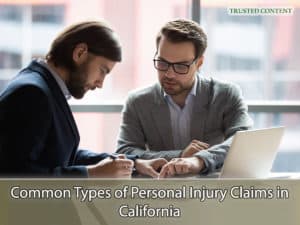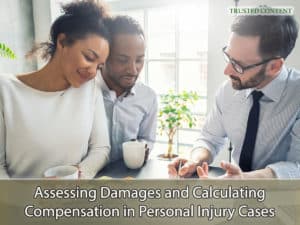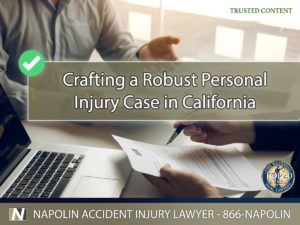Crafting a Robust Personal Injury Case in Ontario, California
Personal injury law in California is designed to offer justice and compensation to individuals who have been harmed due to another party’s negligence or intentional misconduct. However, the path to securing fair compensation is fraught with challenges that can overwhelm the average person. With Napolin Accident Injury Lawyer’s extensive experience in personal injury litigation, injured citizens of southern California can gain a clear understanding of their rights and the steps needed to build a strong personal injury case. This article explores the key elements of crafting a robust personal injury claim, offering insights and strategies to guide injury victims through the process.
Overview of California Personal Injury Law
Key Principles of Personal Injury Law in California
Negligence is the cornerstone of personal injury law in California. Most personal injury claims rely on proving that the defendant’s negligent actions directly resulted in the plaintiff’s injuries. California follows a comparative negligence system, which means that plaintiffs can recover compensation even if they are partly at fault. However, their compensation will be reduced by their percentage of fault. For example, if a plaintiff is found to be 20% at fault, they can still recover 80% of the total damages.
The statute of limitations plays a crucial role in personal injury claims. In California, injured individuals have two years from the date of injury to file a lawsuit. However, certain exceptions can apply, such as in cases involving minors or when the injury isn’t immediately discoverable. Navigating these legal intricacies requires professional guidance to avoid missing critical deadlines.

Common Types of Personal Injury Claims in California
Common Types of Personal Injury Claims in California
Auto accidents remain a leading cause of personal injury claims in California due to the state’s high population and traffic density. Establishing liability often involves proving driver negligence, such as distracted driving, speeding, or DUI. Slip and fall incidents also constitute a significant portion of personal injury cases, typically involving premises liability where property owners fail to maintain reasonably safe conditions. In medical malpractice claims, proving that a healthcare provider’s negligence deviated from the standard of care is crucial, which often requires expert testimony.
Workplace injuries, while generally covered by workers’ compensation, can also lead to personal injury claims involving third-party negligence or defective equipment. Defective products, including faulty machinery or consumer goods, can also result in product liability claims against manufacturers, distributors, and retailers.
Establishing Liability and Proving Negligence
Four Essential Elements of Negligence
To establish a strong personal injury case, the plaintiff must prove the following elements of negligence:
Duty of Care: The defendant had a legal obligation to act reasonably to prevent harm. For instance, drivers have a duty to operate their vehicles safely, and property owners have a duty to maintain safe premises.
Breach of Duty: The defendant breached their duty by failing to act as a reasonable person would under similar circumstances. Examples include running a red light or leaving hazardous conditions unaddressed on a property.
Causation: The breach of duty must have directly caused the plaintiff’s injuries. This is typically established through a “but for” test or proving that the breach was a substantial factor.
Damages: The plaintiff must demonstrate that they suffered actual damages, such as medical bills, lost wages, and pain and suffering.
Types of Evidence to Support Liability Claims
Gathering strong evidence is essential to proving negligence and building a robust personal injury case. Key forms of evidence include:
Accident Reports and Police Documentation: Official records provide crucial details on how the accident occurred and may assign preliminary fault.
Medical Records and Expert Testimony: Medical documentation establishes the extent of injuries, while expert testimony helps prove the causal link between the accident and the injuries.
Eyewitness Statements: Witnesses provide independent accounts of the incident, often corroborating the plaintiff’s version of events.
Surveillance Footage and Photographs: Visual evidence can reveal crucial details of the accident scene, hazardous conditions, or the defendant’s actions.
Product and Workplace Safety Documentation: In cases involving defective products or workplace injuries, safety records and inspection reports can highlight negligence.

Assessing Damages and Calculating Compensation in Personal Injury Cases
Assessing Damages and Calculating Compensation in Personal Injury Cases
Economic Damages: These represent quantifiable financial losses, including medical expenses, lost wages, property damage, and future earning potential. Calculating economic damages involves reviewing medical bills, employment records, and expert opinions on future medical needs and lost earning capacity.
Non-Economic Damages: These encompass more subjective losses, such as pain and suffering, emotional distress, loss of enjoyment of life, and disfigurement. Jurors often rely on their judgment and testimony to determine fair compensation for these damages.
Punitive Damages: Applicable in cases involving gross negligence, malicious intent, or willful misconduct. Punitive damages aim to punish the defendant and deter similar conduct in the future. However, they are awarded only in rare cases where the defendant’s actions were particularly egregious.
Factors Impacting Compensation Calculations
Severity of Injuries: More severe injuries, such as spinal cord damage or traumatic brain injuries, typically lead to higher compensation due to long-term medical needs and impact on quality of life.
Impact on Employment and Earning Capacity: If injuries prevent the plaintiff from working or reduce their ability to earn, compensation will account for lost wages and diminished earning capacity.
Long-Term Medical Needs: Some injuries require ongoing treatment or rehabilitation, which must be factored into compensation calculations.
Comparative Fault Considerations: If the plaintiff is partially at fault, their compensation will be reduced proportionately. For instance, a plaintiff found to be 30% at fault will only receive 70% of the total damages.
Navigating Insurance and Legal Challenges
Dealing with Insurance Companies
Insurance companies often employ tactics to minimize payouts or deny claims altogether. They may dispute liability by arguing that their policyholder was not at fault or that the plaintiff was primarily responsible. Adjusters often offer low settlements, hoping that plaintiffs will accept them out of desperation or lack of knowledge. Insurers may also delay settlements to pressure plaintiffs into accepting less or missing the statute of limitations. By stalling negotiations, insurers can force injury victims into financial hardship. Additionally, insurance companies often dispute the severity of injuries by arguing that they are less severe than claimed or were pre-existing conditions.
To counter these tactics, it’s crucial to document all communications with insurers, gather compelling evidence, and negotiate strategically. An experienced attorney can help navigate the complexities of insurance negotiations and secure fair compensation.
Legal Obstacles and Challenges in Personal Injury Cases
Statute of Limitations: Missing the deadline to file a claim can result in losing the right to pursue compensation. Therefore, it’s essential to file promptly (within 2 years of the injury) or seek exceptions if applicable.
Complexities in Proving Negligence: Proving negligence can be challenging, especially in cases with shared fault or limited evidence. Experts may be needed to establish causation or demonstrate safety violations.
Navigating Comparative Fault Issues: California’s comparative fault system means that compensation will be reduced by the plaintiff’s percentage of fault. Successfully arguing for a lower fault percentage can significantly impact the final compensation amount.
Pre-Existing Conditions: Defendants may argue that the plaintiff’s injuries were pre-existing or not exacerbated by the incident, which requires strong medical evidence to refute.
Role of an Experienced Personal Injury Lawyer
Key Benefits of Hiring a Personal Injury Lawyer
Assessment of Claim Value: An experienced attorney can provide an accurate evaluation of potential compensation based on the unique circumstances of the case.
Effective Evidence Collection and Preservation: Lawyers have the expertise to identify and gather crucial evidence that may not be immediately apparent, such as surveillance footage or expert testimony.
Negotiation Expertise: With insurers often employing tactics to minimize payouts, a skilled attorney can negotiate effectively to secure a fair settlement.
Court Representation: If negotiations fail, having representation in court is crucial. An attorney can build a strong case, present compelling arguments, and challenge opposing evidence.

Crafting a Robust Personal Injury Case in Ontario, California
Crafting a Robust Personal Injury Case in Ontario, California
At Napolin Accident Injury Lawyer, we take a client-focused approach, offering personalized attention and legal strategies tailored to each case. With extensive litigation experience in personal injury law, we have a proven track record of securing favorable outcomes for our clients. Our approach begins with a comprehensive case evaluation, involving a thorough analysis of the facts and evidence to assess the strength of the case and potential compensation.
We then develop a personalized strategy to ensure that each client receives a unique legal approach based on their needs and case specifics. Our team specializes in gathering and preserving evidence that may not be immediately apparent, such as surveillance footage and expert testimony, to build a compelling case. We prioritize negotiation to secure fair settlements but are prepared to represent clients in court if necessary.
Crafting a robust personal injury case in California requires a deep understanding of personal injury law, compelling evidence collection, and effective navigation of insurance and legal challenges. Seeking professional legal guidance from Napolin Accident Injury Lawyer early in the process can make a significant difference in securing fair compensation. Contact Napolin Accident Injury Lawyer at (909) 962-8415 for a free consultation.
